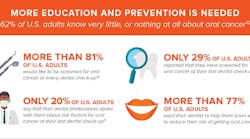According to a recent survey conducted by Vigilant Biosciences in collaboration with the Oral Cancer Foundation, Head and Neck Cancer Alliance, and Support for People with Oral and Head and Neck Cancer, more than 60% of consumers know very little or nothing about oral cancer—a disease that nearly 50,000 people are diagnosed with in the United States every year.
The survey also determined that, while 81% would like to be screened for oral cancer at every dental check-up, only 29% are. Other notable statistics were:
- Only 20% of U.S. consumers say that their dental professional spoke with them about risk factors for oral cancer at their last dental appointment
- 59% of adults are not aware that HPV is a risk factor for oral cancer
To view a Vigilant report about the survey, click here.
The report also noted, “Survey respondents also underestimated the death rate for oral cancer. Only 17% of those surveyed were aware that 40% of people diagnosed with oral cancer die within five years, with most believing the five-year survival rate to be much higher.”
Most cases of oral cancer are found in the late stages, resulting in an extremely high death rate. Vigilant teamed with industry advocates to launch an awareness campaign for National Oral Cancer Awareness Month (April) and National Oral, Head and Neck Cancer Awareness Week (April 2-9) to educate consumers on the risks for oral cancer and the importance of regular screening.
Brian Hill, the executive director of the Oral Cancer Foundation, said, “As an oral cancer survivor and advocate for 18 years, I see that the biggest challenge today is increasing public and professional awareness and involvement. We need to educate both on the risk factors they can avoid, recognition of early signs and symptoms, and the importance of annual screenings.”






